Simulation and Analysis of the Dynamic Characteristics of Groundwater in Taliks in the Eruu Area, Central Yakutia
Abstract
1. Introduction
2. Study Area and Data Pre-Processing
2.1. Overview of the Study Area
2.2. Data Source and Pre-Processing
3. Construction of Simulation
3.1. Construction of the Conceptual Hydrogeological Model
3.2. Construction of the Groundwater Mathematical Model
3.2.1. Mathematical Model
3.2.2. Boundary Conditions
3.2.3. Hydrogeological Parameters
3.2.4. Source and Sink Terms
4. Results and Analysis
4.1. Model Identification and Analysis
4.2. Dynamic Changes in the Groundwater Level
4.3. Dynamic Changes in the Amount of Groundwater Discharge
5. Discussion and Conclusions
5.1. Discussion
5.2. Conclusions
- (1)
- According to the analysis of the measured data on water levels in well 14E/2014, the difference between the simulated and measured values of groundwater level in monitoring wells for over 99% of the measurements was less than 0.1 m. The average difference between the measured (excluding missing values) and simulated values of groundwater level in monitoring wells was 0.028 m/d.
- (2)
- The annual average water level in the study area declined. The simulated value dropped at a rate of 0.10 m/a, with only a gap of 0.01 m/a with the measured value. Meanwhile, the simulated water head was greatly influenced by the terrain, especially in the central area, where the head decreased rapidly from the perimeter toward the lakes (8.9 m/km on average).
- (3)
- From 1 September 2014 to 31 August 2015, the mean value of the simulated discharge from the springs in the study area was 3888.39 L/d, which was in line with the results of previous monitoring (the average flow was 4147.20 L/d and 3715.20 L/d in 2014 and 2015, respectively). The discharge process is closely related to various factors, such as the freeze–thaw state, temperature, and hydrostatic pressure of the active layer.
Author Contributions
Funding
Institutional Review Board Statement
Informed Consent Statement
Data Availability Statement
Conflicts of Interest
References
- Slaymaker, O.; Kelly, R. The Cryosphere and Global Environmental Change; Blackwell Publishing: Hoboken, NJ, USA, 2009. [Google Scholar] [CrossRef]
- Van Everdingen, R.O. Geocryological terminology. Can. J. Earth Sci. 1976, 13, 862–867. [Google Scholar] [CrossRef]
- Dobinski, W. Permafrost. Earth-Sci. Rev. 2011, 108, 158–169. [Google Scholar] [CrossRef]
- Wang, Q.; Zhang, T.; Jin, H.; Cao, B.; Peng, X.; Wang, K.; Li, L.; Guo, H.; Liu, J.; Cao, L. Observational study on the active layer freeze–thaw cycle in the upper reaches of the Heihe River of the north-eastern Qinghai-Tibet Plateau. Quatern Int. 2017, 440, 13–22. [Google Scholar] [CrossRef]
- Wang, G.; Hu, H.; Li, T. The influence of freeze–thaw cycles of active soil layer on surface runoff in a permafrost watershed. J. Hydrol. 2009, 375, 438–449. [Google Scholar] [CrossRef]
- Woo, M.K.; Kane, D.L.; Carey, S.K.; Yang, D. Progress in permafrost hydrology in the new millennium. Permafr. Periglac. Process. 2008, 19, 237–254. [Google Scholar] [CrossRef]
- Lamontagne-Hallé, P.; Mckenzie, J.M.; Kurylyk, B.L.; Zipper, S.C. Changing groundwater discharge dynamics in permafrost regions. Environ. Res. Lett. 2018, 13, 084017. [Google Scholar] [CrossRef]
- Jin, H.; Huang, Y.; Bense, V.F.; Ma, Q.; Marchenko, S.S.; Shepelev, V.V.; Hu, Y.; Liang, S.; Spektor, V.V.; Jin, X.; et al. Permafrost degradation and its hydrogeological impacts. Water 2022, 14, 372. [Google Scholar] [CrossRef]
- Xiao, X.; Yu, Z.; Wang, J.; Zhou, Y.; Liu, K.; Liu, Z.; Wu, H.; Zhang, C. Hydrochemistry of surface waters in a permafrost headwater catchment in the Northeastern Tibetan Plateau. J. Hydrol. 2023, 617, 128878. [Google Scholar] [CrossRef]
- Arenson, L.U.; Harrington, J.S.; Koenig, C.E.M.; Wainstein, P.A. Mountain permafrost hydrology-a practical review following studies from the andes. Geosciences 2022, 12, 48. [Google Scholar] [CrossRef]
- Li, J.; Chen, W.; Liu, Z.; Li, J.; Chen, W.; Liu, Z. The Qinghai–Tibet Railway Geological Environment; Springer: Berlin/Heidelberg, Germany, 2018; pp. 11–71. [Google Scholar] [CrossRef]
- Pavlova, N.A.; Kolesnikov, A.B.; Efremov, V.S.; Shepelev, V.V. Groundwater chemistry in intrapermafrost taliks in Central Yakutia. Water Resour. 2016, 43, 353–363. [Google Scholar] [CrossRef]
- Marques, J.M.; Graça, H.; Eggenkamp, H.G.; Neves, O.; Carreira, P.M.; Matias, M.J.; Mayer, B.; Nunes, D.; Trancoso, V.N. Isotopic and hydrochemical data as indicators of recharge areas, flow paths and water–rock interaction in the Caldas da Rainha–Quinta das Janelas thermomineral carbonate rock aquifer (Central Portugal). J. Hydrol. 2013, 476, 302–313. [Google Scholar] [CrossRef]
- Jafarov, E.E.; Coon, E.T.; Harp, D.R.; Wilson, C.J.; Painter, S.L.; Atchley, A.L.; Romanovsky, V.E. Modeling the role of preferential snow accumulation in through talik development and hillslope groundwater flow in a transitional permafrost landscape. Environ. Res. Lett. 2018, 13, 105006. [Google Scholar] [CrossRef]
- Semernya, A.A.; Gagarin, L.A.; Bazhin, K.I. Cryohydrogeological features of the site of intrapermafrost aquifer distribution at the Eruu spring area (central Yakutia). Cryos Earth 2018, 22, 29–38. [Google Scholar] [CrossRef]
- Riseborough, D.; Shiklomanov, N.; Etzelmüller, B.; Gruber, S.; Marchenko, S. Recent advances in permafrost modelling. Permafr. Periglac. Process 2008, 19, 137–156. [Google Scholar] [CrossRef]
- Hornum, M.T.; Hodson, A.J.; Jessen, S.; Bense, V.; Senger, K. Numerical modelling of permafrost spring discharge and open-system pingo formation induced by basal permafrost aggradation. Cryosphere 2020, 14, 4627–4651. [Google Scholar] [CrossRef]
- Liu, W.; Fortier, R.; Molson, J.; Lemieux, J.M. Three-Dimensional Numerical Modeling of Cryo-Hydrogeological Processes in a River-Talik System in a Continuous Permafrost Environment. Water Resour. Res. 2022, 58, e2021WR031630. [Google Scholar] [CrossRef]
- Liao, C.; Zhuang, Q. Quantifying the Role of Permafrost Distribution in Groundwater and Surface Water Interactions Using a Three-Dimensional Hydrological Model. Arct. Antarct. Alp. Res. 2018, 49, 81–100. [Google Scholar] [CrossRef]
- Frampton, A.; Painter, S.L.; Destouni, G. Permafrost degradation and subsurface-flow changes caused by surface warming trends. Hydrogeol. J. 2013, 21, 271. [Google Scholar] [CrossRef]
- Koch, J.C.; McKnight, D.M.; Neupauer, R.M. Simulating unsteady flow, anabranching, and hyporheic dynamics in a glacial meltwater stream using a coupled surface water routing and groundwater flow model. Water Resour. Res. 2011, 47, W05530. [Google Scholar] [CrossRef]
- Ge, S.; McKenzie, J.; Voss, C.; Wu, Q. Exchange of groundwater and surface-water mediated by permafrost response to seasonal and long term air temperature variation. Geophys. Res. Lett. 2011, 38, L14402. [Google Scholar] [CrossRef]
- Gaiolini, M.; Colombani, N.; Busico, G.; Rama, F.; Mastrocicco, M. Impact of Boundary Conditions Dynamics on Groundwater Budget in the Campania Region (Italy). Water 2022, 14, 2462. [Google Scholar] [CrossRef]
- Woo, M.-k.; Mollinga, M.; Smith, S.L. Modeling Maximum Active Layer Thaw in Boreal and Tundra Environments Using Limited Data; Springer: Berlin/Heidelberg, Germany, 2008; pp. 125–137. [Google Scholar] [CrossRef]
- Oelke, C.; Zhang, T. A model study of circum-Arctic soil temperatures. Permafr. Periglac. Process 2004, 15, 103–121. [Google Scholar] [CrossRef]
- Zhang, T. Influence of the seasonal snow cover on the ground thermal regime: An overview. Rev. Geophys. 2005, 43, RG4002. [Google Scholar] [CrossRef]
- Iwata, Y.; Hayashi, M.; Hirota, T. Comparison of snowmelt infiltration under different soil-freezing conditions influenced by snow cover. Vadose Zone J. 2008, 7, 79–86. [Google Scholar] [CrossRef]
- Frampton, A.; Painter, S.; Lyon, S.W.; Destouni, G. Non-isothermal, three-phase simulations of near-surface flows in a model permafrost system under seasonal variability and climate change. J. Hydrol. 2011, 403, 352–359. [Google Scholar] [CrossRef]
- Breemer, C. Glacier Science and Environmental Change; Blackwell Publishing: Hoboken, NJ, USA, 2006; pp. 63–66. [Google Scholar] [CrossRef]
- Wellman, T.P.; Voss, C.I.; Walvoord, M.A. Impacts of climate, lake size, and supra-and sub-permafrost groundwater flow on lake-talik evolution, Yukon Flats, Alaska (USA). Hydrogeol. J. 2013, 21, 281. [Google Scholar] [CrossRef]
- Ling, F.; Wu, Q.; Zhang, T.; Niu, F. Modelling open-talik formation and permafrost lateral thaw under a thermokarst lake, Beiluhe Basin, Qinghai-Tibet Plateau. Permafr. Periglac. Process. 2012, 23, 312–321. [Google Scholar] [CrossRef]
- Semernya, A. Intrapermafrost Water Resource Assessment in Central Yakutia According to Observations of Spring Run-off (Case Study of Eruu Spring). Sci. Educ. 2016, 81, 41–47. [Google Scholar] [CrossRef]
- Price, D.T.; McKenney, D.W.; Nalder, L.A.; Hutchinson, M.F.; Jennifer, L.K. A comparison of two statistical methods for spatial interpolation of Canadian monthly mean climate data. Agric. For. Meteorol. 2000, 101, 81–94. [Google Scholar] [CrossRef]
- Walvoord, M.A.; Voss, C.I.; Wellman, T.P. Influence of permafrost distribution on groundwater flow in the context of climate-driven permafrost thaw: Example from Yukon Flats Basin, Alaska, United States. Water Resour. Res. 2012, 48, W07524. [Google Scholar] [CrossRef]
- Dobiński, W. Permafrost active layer. Earth-Sci. Rev. 2020, 208, 103301. [Google Scholar] [CrossRef]
- Zhang, T.; Frauenfeld, O.W.; Serreze, M.C.; Etringer, A.; Oelke, C.; McCreight, J.; Barry, R.G.; Gilichinsky, D.; Yang, D.; Ye, H. Spatial and temporal variability in active layer thickness over the Russian Arctic drainage basin. J. Geophys. Res. Atmos. 2005, 110, D16101. [Google Scholar] [CrossRef]
- Isaev, V.; Kioka, A.; Kotov, P.; Sergeev, D.O.; Uvarova, A.; Koshurnikov, A.; Komarov, O. Multi-Parameter Protocol for Geocryological Test Site: A Case Study Applied for the European North of Russia. Energies 2022, 15, 2076. [Google Scholar] [CrossRef]
- Harbaugh, A.W. MODFLOW-2005, the US Geological Survey Modular Ground-Water Model: The Ground-Water Flow Process; US Department of the Interior: Washington, DC, USA; US Geological Survey: Reston, VA, USA, 2005; Volume 6.
- Quinton, W.L.; Baltzer, J.L. The active-layer hydrology of a peat plateau with thawing permafrost (Scotty Creek, Canada). Hydrogeol. J. 2012, 21, 201–220. [Google Scholar] [CrossRef]
- Zhou, G.; Cui, M.; Wan, J.; Zhang, S. A Review on Snowmelt Models: Progress and Prospect. Sustainability 2021, 13, 11485. [Google Scholar] [CrossRef]
- Condon, L.E.; Kollet, S.; Bierkens, M.F.; Fogg, G.E.; Maxwell, R.M.; Hill, M.C.; Fransen, H.J.H.; Verhoef, A.; Van Loon, A.F.; Sulis, M. Global groundwater modeling and monitoring: Opportunities and challenges. Water Resour. Res. 2021, 57, e2020WR029500. [Google Scholar] [CrossRef]
- Tan, C.; Tung, C.; Chen, C.; Yeh, W. An integrated optimization algorithm for parameter structure identification in groundwater modeling. Adv. Water Resour. 2008, 31, 545–560. [Google Scholar] [CrossRef]
- Cui, G.; Liu, Y.; Su, X.; Tong, S.; Jiang, M. Aquifer exploitation potential at a riverbank filtration site based on spatiotemporal variations in riverbed hydraulic conductivity. J. Hydrol. Reg. Stud. 2022, 41, 101068. [Google Scholar] [CrossRef]
- Wang, S.; Cui, G.; Li, X.; Liu, Y.; Li, X.; Tong, S.; Zhang, M. GRACE Satellite-Based Analysis of Spatiotemporal Evolution and Driving Factors of Groundwater Storage in the Black Soil Region of Northeast China. Remote Sens. 2023, 15, 704. [Google Scholar] [CrossRef]
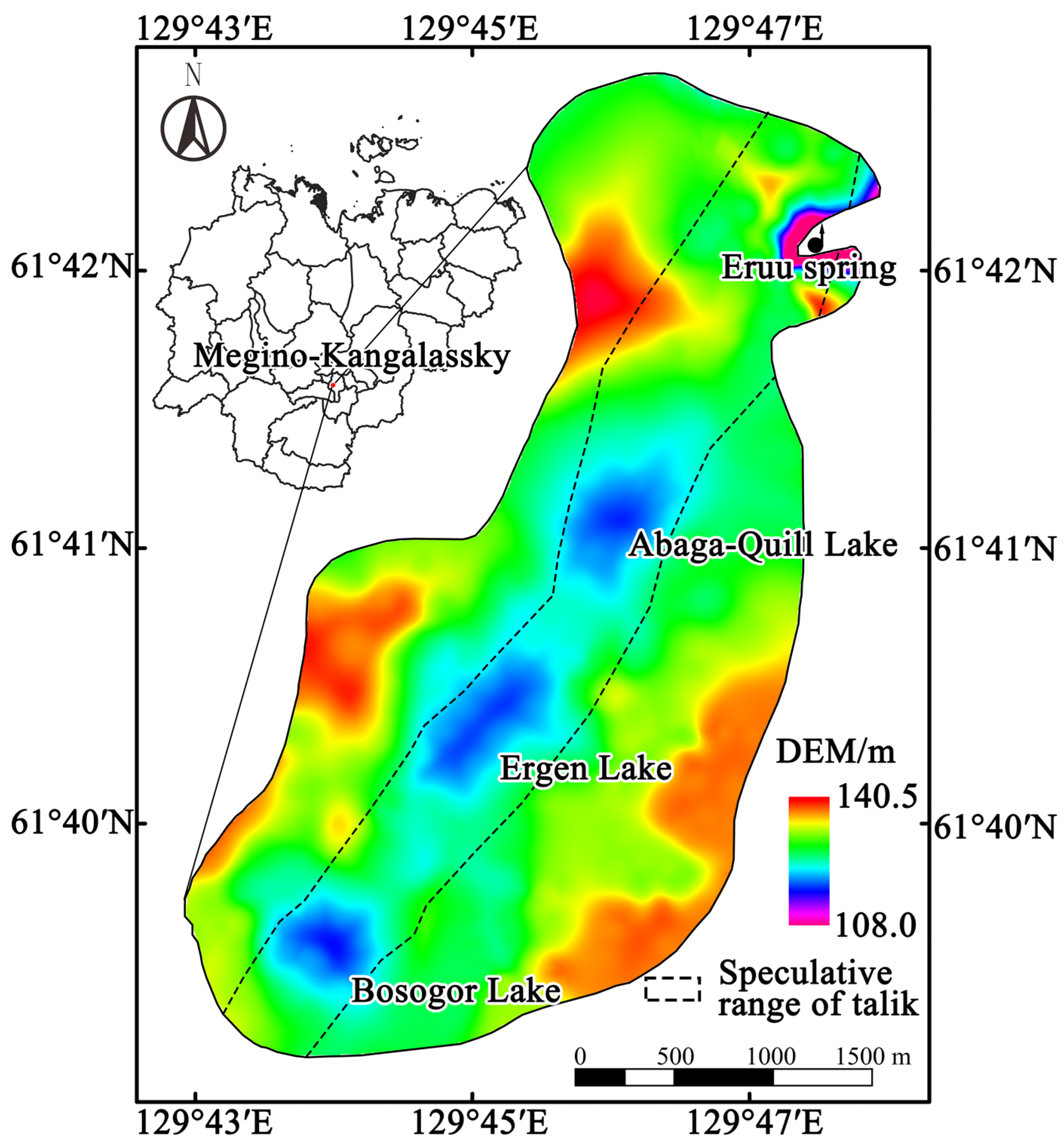
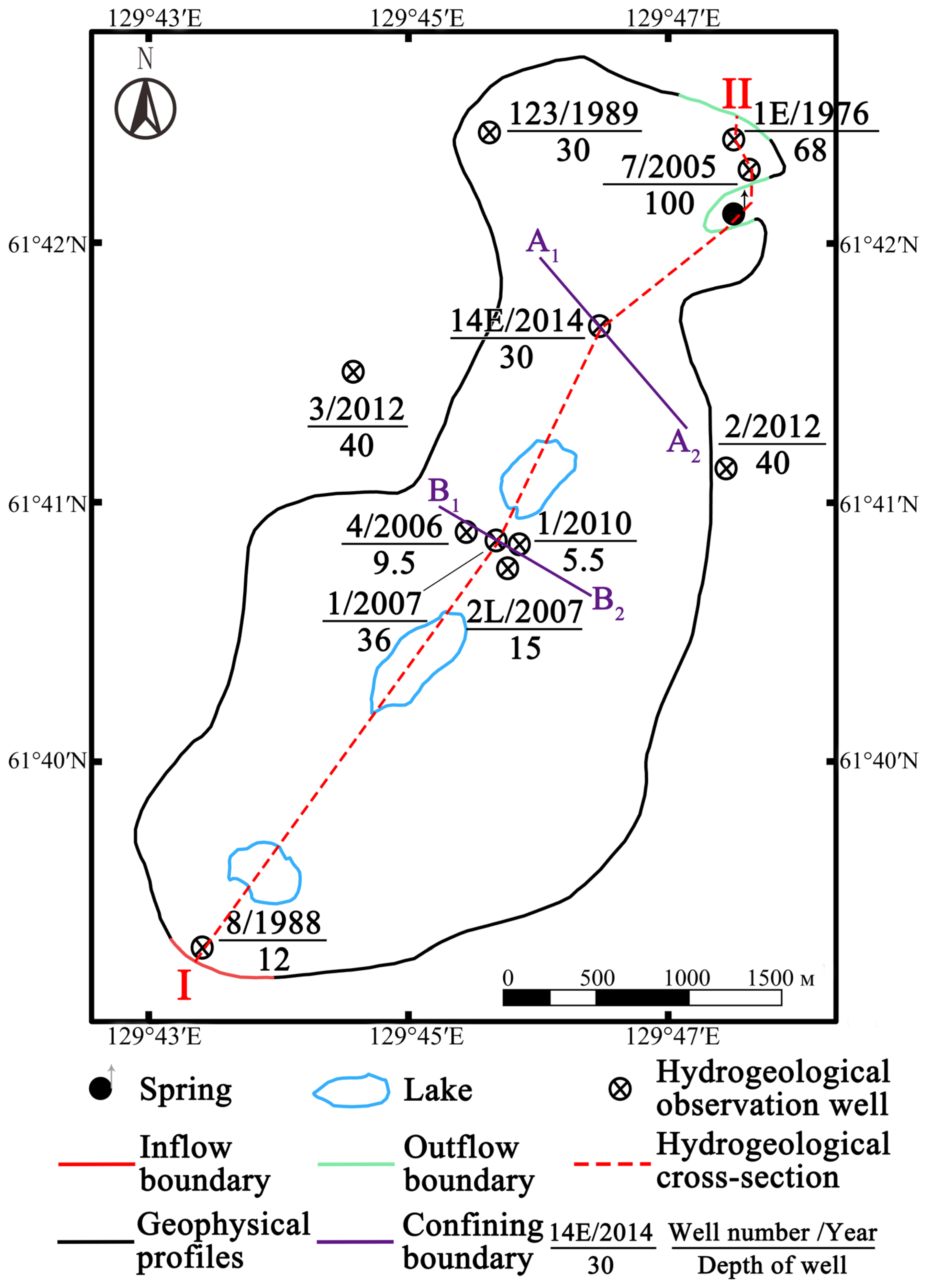
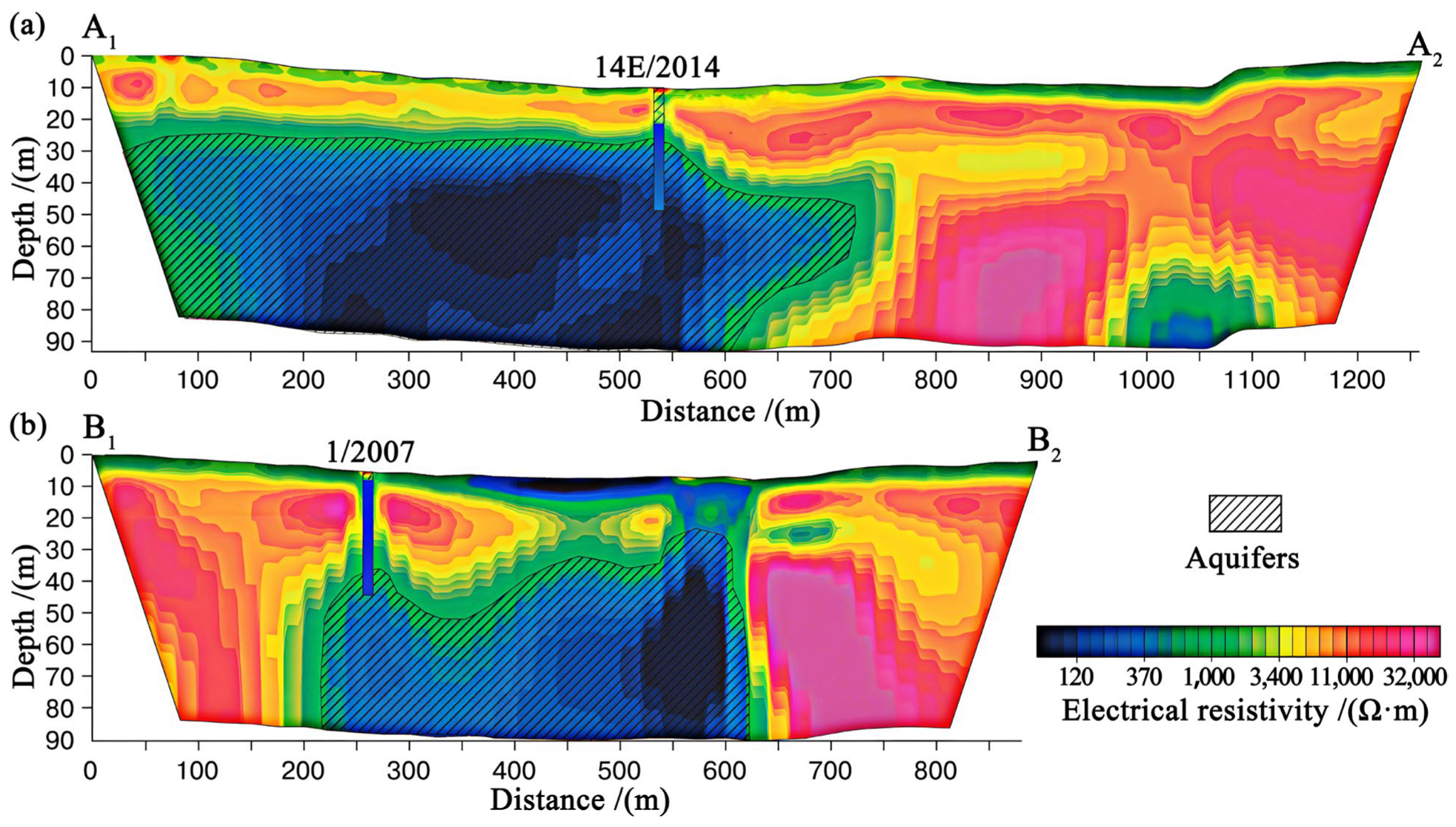
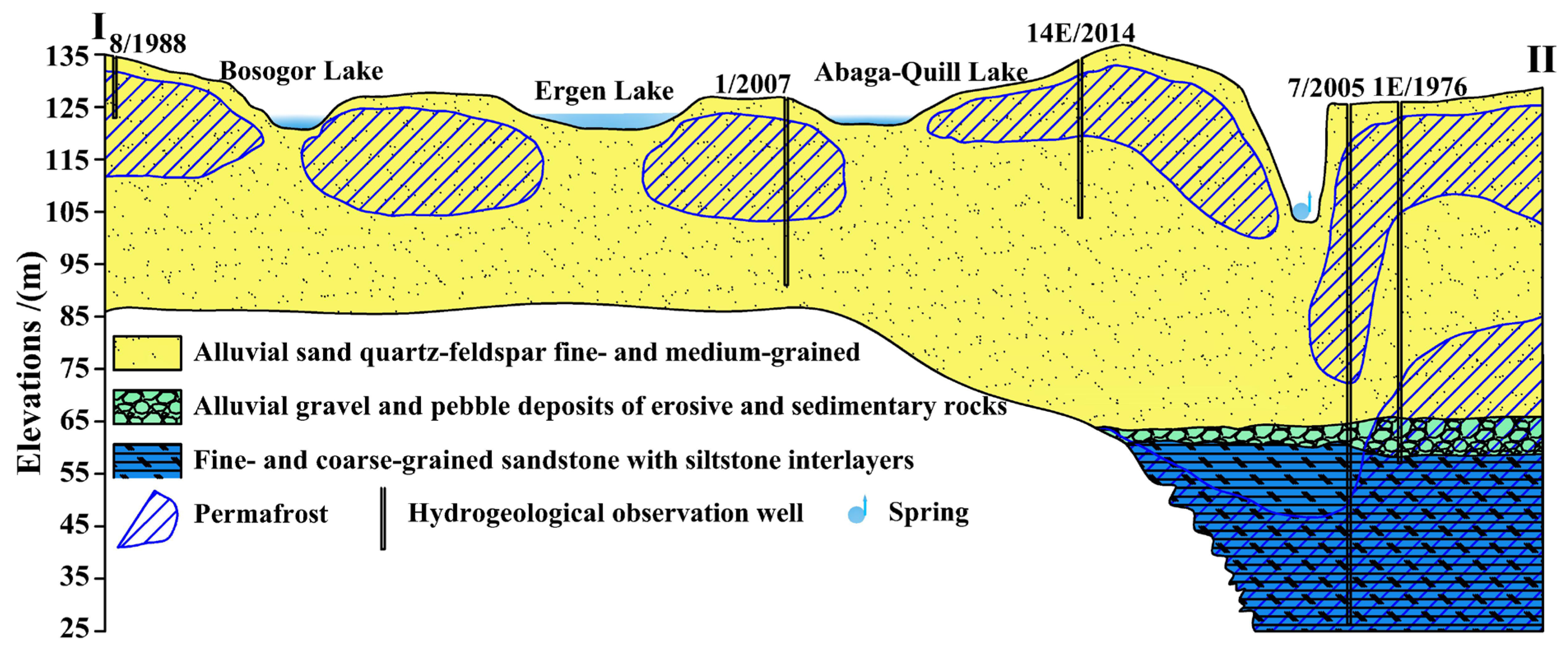
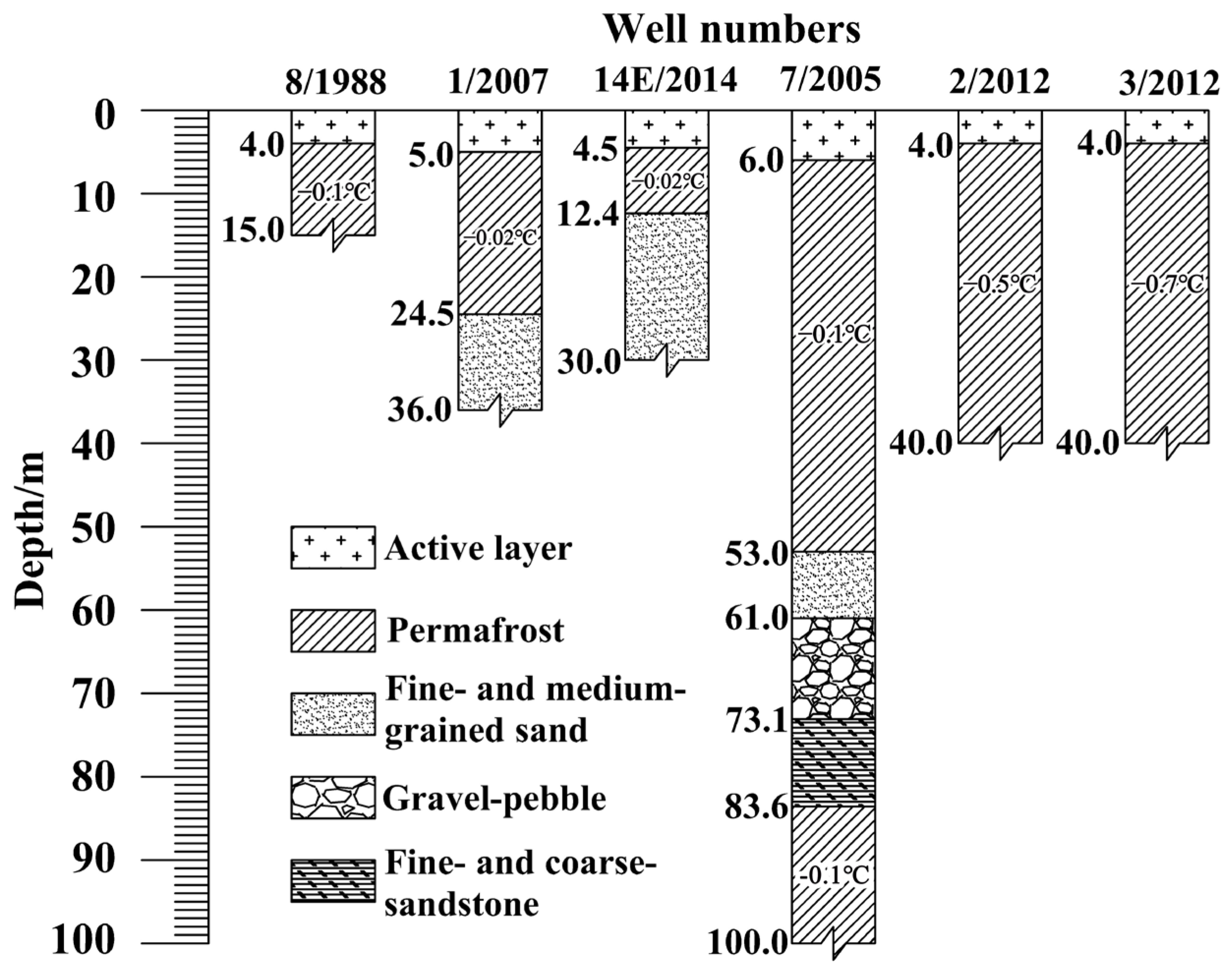



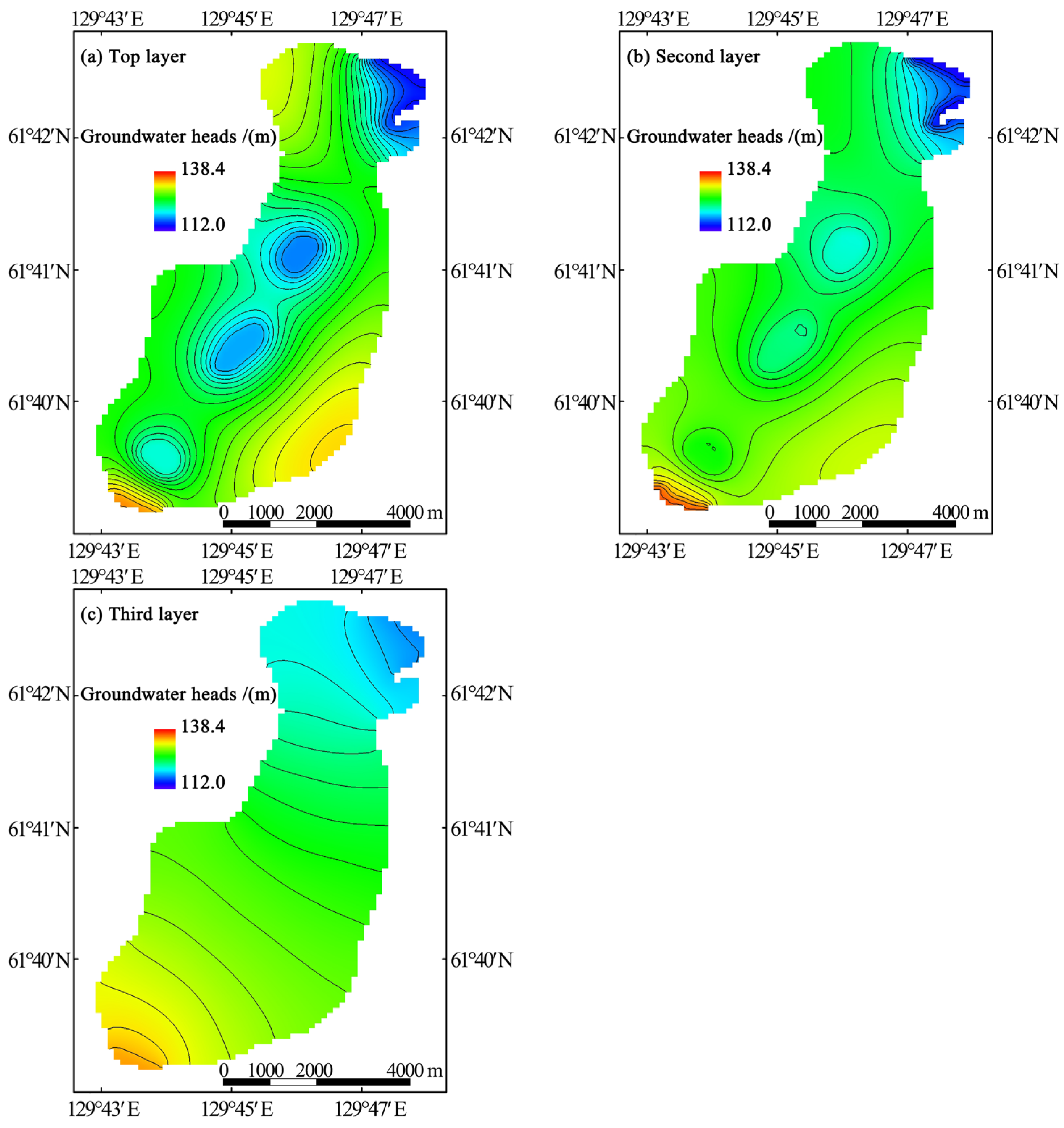
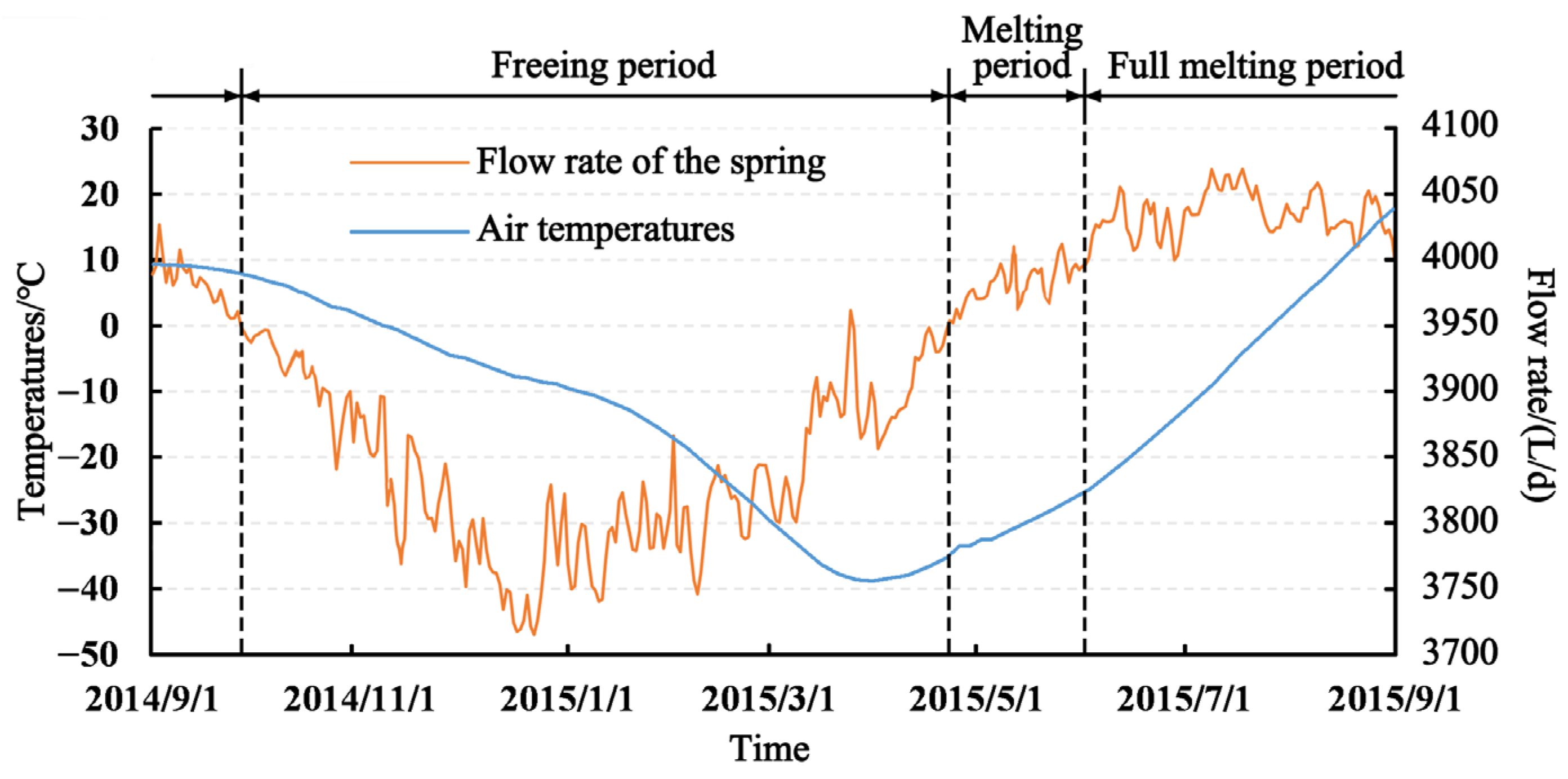
| Layer | Horizontal Permeability Coefficient | Vertical Permeability Coefficient | Specific Yield |
|---|---|---|---|
| Active layer | 8.0 × 10−5~6.5 | 1.2 × 10−5~2.67 | 0.21 × 10−5~0.18 |
| Permafrost | 8.0 × 10−5 | 1.2 × 10−5 | 0.21 × 10−5 |
| Fine- and medium-grained sand | 4.25~6.50 | 1.25~2.25 | 0.12~0.14 |
| Gravel–pebble | 113.08 | 40.50 | 0.20 |
| Fine- and coarse-sandstone | 14.55 | 4.85 | 0.06 |
| Time Interval | Maximum Measured Value/m | Maximum Simulated Value/m | Minimum Measured Value/m | Minimum Simulated Value/m | Measured Annual Average Water Level/m | Simulated Annual Average Water Level/m | Measured Annual Fluctuation/m | Simulated Annual Fluctuation/m |
|---|---|---|---|---|---|---|---|---|
| 1.9.2014–31.8.2015 | 122.79 (2015.4.29) | 122.56 (2015.4.1) | 122.17 (2015.8.31) | 122.20 (2015.8.31) | 122.44 | 122.41 | 0.82 | 0.36 |
| 1.9.2015–31.8.2016 | 122.51 (2016.3.23) | 122.32 (2016.4.18) | 122.00 (2016.8.27) | 122.04 (2016.8.31) | 122.20 | 122.19 | 0.51 | 0.28 |
| 1.9.2016–31.8.2017 | - | 122.23 (2017.5.24) | - | 122.02 (2017.8.31) | - | 122.11 | - | 0.21 |
| 1.9.2017–31.8.2018 | - | 122.08 (2018.4.18) | - | 121.80 (2018.8.31) | - | 121.97 | - | 0.28 |
| 1.9.2018–31.8.2019 | 122.09 (2019.5.16) | 122.01 (2019.4.16) | 121.77 (2019.8.31) | 121.75 (2019.8.31) | 121.90 | 121.89 | 0.32 | 0.26 |
Disclaimer/Publisher’s Note: The statements, opinions and data contained in all publications are solely those of the individual author(s) and contributor(s) and not of MDPI and/or the editor(s). MDPI and/or the editor(s) disclaim responsibility for any injury to people or property resulting from any ideas, methods, instructions or products referred to in the content. |
© 2023 by the authors. Licensee MDPI, Basel, Switzerland. This article is an open access article distributed under the terms and conditions of the Creative Commons Attribution (CC BY) license (https://creativecommons.org/licenses/by/4.0/).
Share and Cite
Yu, M.; Pavlova, N.; Dai, C.; Guo, X.; Zhang, X.; Gao, S.; Wei, Y. Simulation and Analysis of the Dynamic Characteristics of Groundwater in Taliks in the Eruu Area, Central Yakutia. Sustainability 2023, 15, 9590. https://doi.org/10.3390/su15129590
Yu M, Pavlova N, Dai C, Guo X, Zhang X, Gao S, Wei Y. Simulation and Analysis of the Dynamic Characteristics of Groundwater in Taliks in the Eruu Area, Central Yakutia. Sustainability. 2023; 15(12):9590. https://doi.org/10.3390/su15129590
Chicago/Turabian StyleYu, Miao, Nadezhda Pavlova, Changlei Dai, Xianfeng Guo, Xiaohong Zhang, Shuai Gao, and Yiru Wei. 2023. "Simulation and Analysis of the Dynamic Characteristics of Groundwater in Taliks in the Eruu Area, Central Yakutia" Sustainability 15, no. 12: 9590. https://doi.org/10.3390/su15129590
APA StyleYu, M., Pavlova, N., Dai, C., Guo, X., Zhang, X., Gao, S., & Wei, Y. (2023). Simulation and Analysis of the Dynamic Characteristics of Groundwater in Taliks in the Eruu Area, Central Yakutia. Sustainability, 15(12), 9590. https://doi.org/10.3390/su15129590







